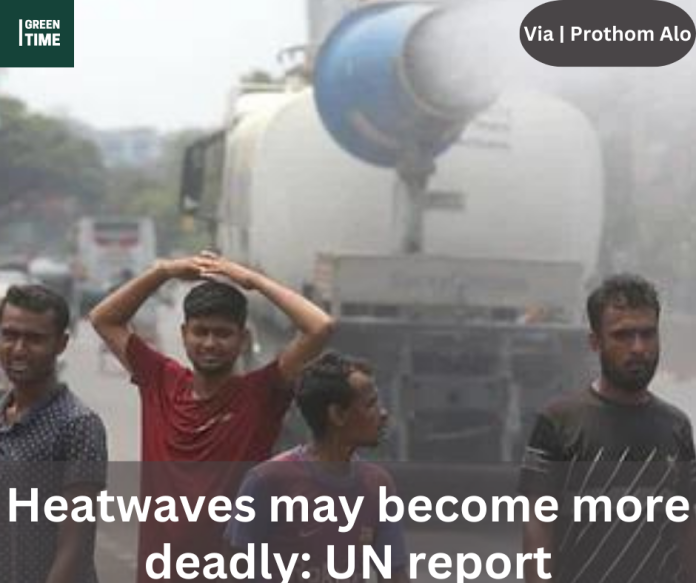In the coming years, heatwaves may become stronger and pose a greater threat to Bangladesh and India.
Heatwaves that hit across Asia, including Bangladesh, during the summer may become more deadly. The heat wave that appeared last April with a severe form is still sweeping through six Asian countries. It may become stronger in the coming years and pose a major threat to Bangladesh and India.
These things were said in a research report published jointly by the World Weather Attribution and Red Cross Climate Center this month. The findings of the study were also cited in a report released yesterday by the United Nations Organization for Humanitarian Affairs (UNOCHA) on the ongoing heat wave in Asia.
State Minister of Disaster Management and Relief Ministry Mohibbur Rahman said, “We consider the heat wave as a disaster. We are starting the work of helping the people affected and victims of death. The government is also working to deal with the damage caused in agriculture, health and other sectors.
Yesterday, the highest temperature in the country was in Chuadanga – 39.6 degrees Celsius, in Dhaka it was 37.3 degrees Celsius. The heatwave may continue for the next three-four days.
Meanwhile, the Directorate of Meteorology yesterday issued a special warning of heat wave in four divisions of the country – Dhaka, Rajshahi, Rangpur and Khulna. Yesterday, heatwave swept through most of the country. Yesterday, the highest temperature in the country was in Chuadanga – 39.6 degrees Celsius, in Dhaka it was 37.3 degrees Celsius. The heatwave may continue for the next three-four days.
The report of UNOCHA highlights the observation data of the Bangladesh Red Crescent Society and states that residents of 56 out of 64 districts of Bangladesh have been affected by the heat wave. In the meantime, it has affected the lives and livelihood of 12.5 million people of the country in various ways. Out of this, at least 1 million people have suffered severe damage. The organization has highlighted the death of 20 people from government and private accounts.
Secretary General of Red Crescent Society Bangladesh Kazi Shafiqul Azam said, “In the history of the country, we have not faced severe heat waves in so many areas. Such heatwaves may appear regularly with more intensity in the coming years. We have to be prepared keeping this fear in mind. He suggested to increase the work of making umbrellas, water containers, cool centers or cooling centers for the poor people during summer.
According to the report of UNOCHA, due to the heat wave in Bangladesh, many people are suffering from dehydration, fainting, body imbalance, vomiting, fever, diarrhea and pneumonia. Dhaka had the highest temperature on April 29. A total of 6 people died that day in the capital. Then the normal temperature of Bangladesh is 33 degrees Celsius. But most of the time the temperature is 6 degrees higher than it has been felt.
According to the report, heat wave is going on in Bangladesh, India, Thailand, Vietnam, Philippines in this May as well as last April. Starting from the agriculture of these countries, the public health is under serious threat. The heatwave is beginning to have long-term effects on the agricultural system of the region, one of the world’s major rice-producing centers. Scarcity of irrigation water, increased incidence of insects and increased agricultural wages.
Dhaka had the highest temperature on April 29. A total of 6 people died that day in the capital. Then the normal temperature of Bangladesh is 33 degrees Celsius. But most of the time the temperature is 6 degrees higher than it has been felt.
Bangladesh Rice Research Institute scientist and climate-researcher. Kamruzzaman Milan said, a portion of Boro rice is planted in February. It flowers in April. But during this period the temperature is above 35 degrees Celsius for several consecutive days causing crop damage. This is also the case with mango and litchi. In the coming years, such temperature may have a negative impact on the production of rice and other seasonal fruits and vegetables.
According to the United Nations, the highest number of people died in the heat wave in Magura district. Although the heat wave started from the beginning of April, it became severe on April 21.And the hottest day was April 24. On that day, the maximum temperature in most parts of the country, including the capital, reached 40 degrees Celsius. Chuadanga, Chapainawabganj, Natore, Kushtia, Jhenaidah, Meherpur, Bogra, Rajshahi, Pabna, Khulna, Bagerhat, Jessore and Patuakhali were the hottest. Earlier in April 2019, heat wave was recorded for 23 consecutive days. Last April’s heat wave broke the previous record. 70 percent of Bangladesh’s area was at risk due to the heat wave.
Bangladesh Rice Research Institute scientist and climate-researcher. Kamruzzaman Milan said, a portion of Boro rice is planted in February. It flowers in April. But during this period the temperature is above 35 degrees Celsius for several consecutive days causing crop damage.

